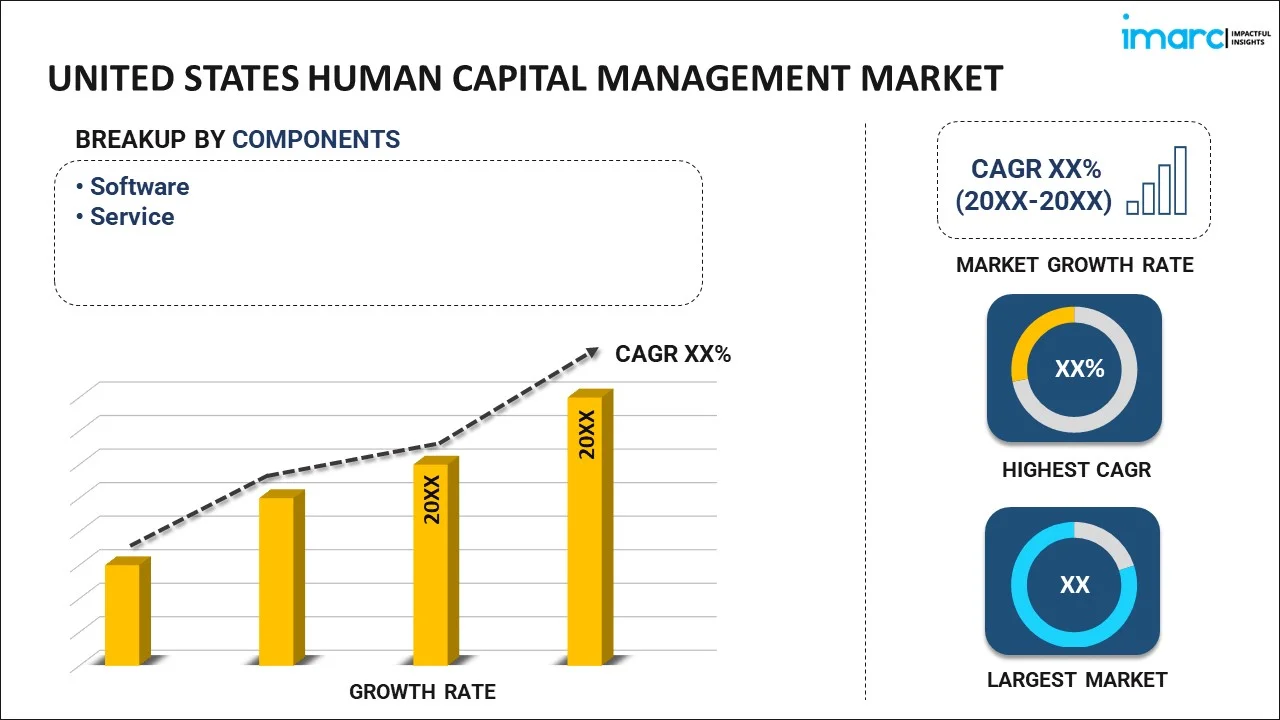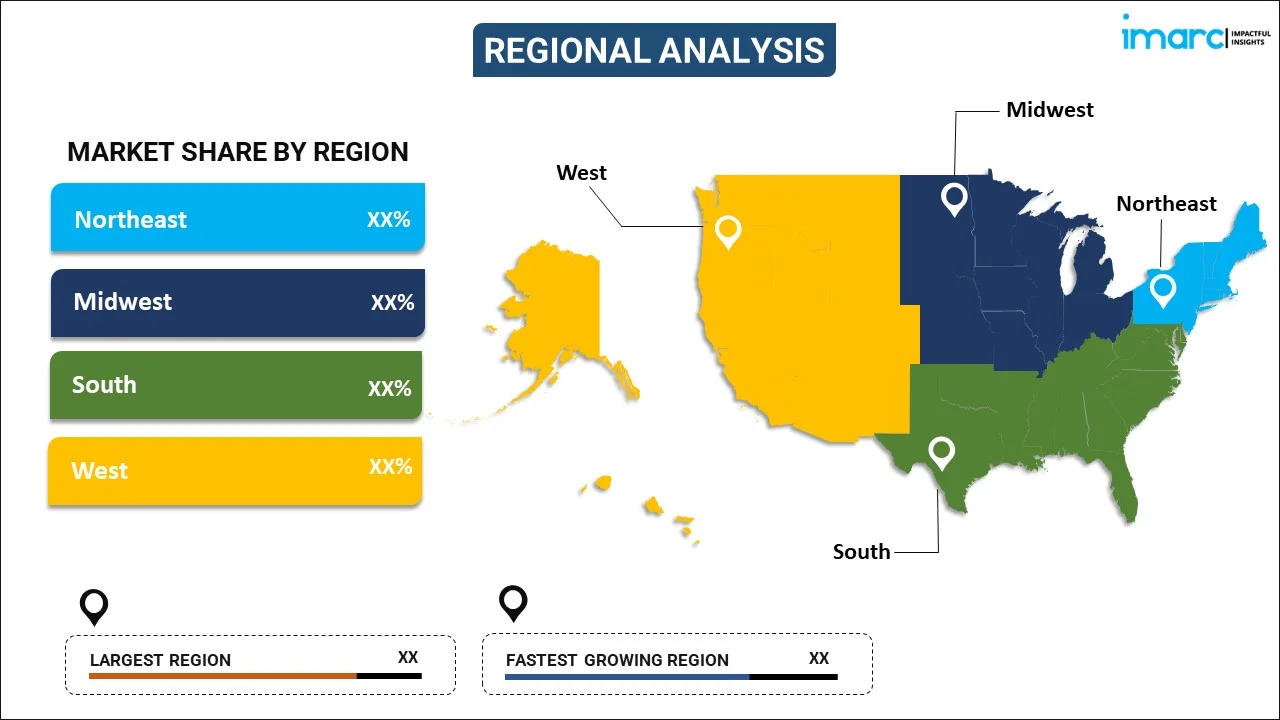
United States Human Capital Management Market Report by Component (Software, Service), Deployment Type (Cloud-based, On-premises), Industry Vertical (BFSI, Retail, IT and Telecommunication, Healthcare, Hospitality, Government, Manufacturing, and Others), and Region 2025-2033
Market Overview:
United States human capital management market size reached USD 6.1 Billion in 2024. Looking forward, IMARC Group expects the market to reach USD 9.5 Billion by 2033, exhibiting a growth rate (CAGR) of 5% during 2025-2033. The increasing prevalence of digital transformation to streamline HR processes, improve efficiency, and enhance the overall employee experience, is driving the market.
|
Report Attribute
|
Key Statistics
|
|---|---|
|
Base Year
|
2024 |
|
Forecast Years
|
2025-2033
|
|
Historical Years
|
2019-2024
|
| Market Size in 2024 | USD 6.1 Billion |
| Market Forecast in 2033 | USD 9.5 Billion |
| Market Growth Rate (2025-2033) | 5% |
Human capital management (HCM) refers to the strategic approach of acquiring, managing, and developing an organization's workforce to maximize individual and collective performance. It encompasses a range of activities, including recruitment, onboarding, training, performance management, and employee retention. HCM recognizes employees as valuable assets and focuses on optimizing their skills, knowledge, and abilities to drive organizational success. By aligning human resources practices with business goals, HCM aims to enhance employee engagement, productivity, and satisfaction. This holistic approach involves data-driven decision-making, talent development, and fostering a positive work culture. In essence, HCM recognizes that the workforce is a critical component of a company's overall success and seeks to leverage human potential for sustainable growth and competitiveness.
United States Human Capital Management Market Trends:
The United States human capital management market drivers are multifaceted, stemming from the evolving nature of work and organizational dynamics. Firstly, the increasing emphasis on digital transformation has catalyzed the demand for HCM solutions. As organizations migrate towards cloud-based platforms for streamlined operations, HCM tools become integral in managing workforce data efficiently. Additionally, the rising trend of remote work, accelerated by regional events, has propelled the need for robust HCM systems that can adeptly handle dispersed teams. Furthermore, the competitive landscape, marked by a constant quest for talent, has elevated the significance of HCM in talent acquisition, retention, and development. Moreover, regulatory compliance and the ever-changing legal landscape contribute to the momentum of the HCM market. Organizations seek HCM solutions that ensure compliance with labor laws, data protection regulations, and industry standards. Furthermore, the growing awareness of the role of employee well-being in organizational success is steering companies towards comprehensive HCM platforms that incorporate features for employee engagement, performance management, and skill development. In essence, the HCM market in the United States is propelled by a synergy of technological advancements, changing work paradigms, regulatory imperatives, and a heightened focus on human capital as a strategic asset in the business landscape.
United States Human Capital Management Market Segmentation:
IMARC Group provides an analysis of the key trends in each segment of the market, along with forecasts at the country level for 2025-2033. Our report has categorized the market based on component, deployment type and industry vertical.
Component Insights:

- Software
- Core HR
- Recruiting
- Workforce Management
- Compensation and Payroll
- Others
- Service
- Managed Service
- Professional
The report has provided a detailed breakup and analysis of the market based on the component. This includes software (core HR, recruiting, workforce management, compensation and payroll, and others) and service (managed service and professional).
Deployment Type Insights:
- Cloud-based
- On-premises
A detailed breakup and analysis of the market based on the deployment type have also been provided in the report. This includes cloud-based and on-premises.
Industry Vertical Insights:
- BFSI
- Retail
- IT and Telecommunication
- Healthcare
- Hospitality
- Government
- Manufacturing
- Others
The report has provided a detailed breakup and analysis of the market based on the industry vertical. This includes BFSI, retail, IT and telecommunication, healthcare, hospitality, government, manufacturing, and others.
Regional Insights:

- Northeast
- Midwest
- South
- West
The report has also provided a comprehensive analysis of all the major regional markets, which include Northeast, Midwest, South, and West.
Competitive Landscape:
The market research report has also provided a comprehensive analysis of the competitive landscape. Competitive analysis such as market structure, key player positioning, top winning strategies, competitive dashboard, and company evaluation quadrant has been covered in the report. Also, detailed profiles of all major companies have been provided.
United States Human Capital Management Market Report Coverage:
| Report Features | Details |
|---|---|
| Base Year of the Analysis | 2024 |
| Historical Period | 2019-2024 |
| Forecast Period | 2025-2033 |
| Units | Billion USD |
| Scope of the Report | Exploration of Historical Trends and Market Outlook, Industry Catalysts and Challenges, Segment-Wise Historical and Future Market Assessment:
|
| Components Covered |
|
| Deployment Types Covered | Cloud-based, On-premises |
| Industry Verticals Covered | BFSI, Retail, IT and Telecommunication, Healthcare, Hospitality, Government, Manufacturing, Others |
| Regions Covered | Northeast, Midwest, South, West |
| Customization Scope | 10% Free Customization |
| Post-Sale Analyst Support | 10-12 Weeks |
| Delivery Format | PDF and Excel through Email (We can also provide the editable version of the report in PPT/Word format on special request) |
Key Questions Answered in This Report:
- How has the United States human capital management market performed so far and how will it perform in the coming years?
- What has been the impact of COVID-19 on the United States human capital management market?
- What is the breakup of the United States human capital management market on the basis of component?
- What is the breakup of the United States human capital management market on the basis of deployment type?
- What is the breakup of the United States human capital management market on the basis of industry vertical?
- What are the various stages in the value chain of the United States human capital management market?
- What are the key driving factors and challenges in the United States human capital management?
- What is the structure of the United States human capital management market and who are the key players?
- What is the degree of competition in the United States human capital management market?
Key Benefits for Stakeholders:
- IMARC’s industry report offers a comprehensive quantitative analysis of various market segments, historical and current market trends, market forecasts, and dynamics of the United States human capital management market from 2019-2033.
- The research report provides the latest information on the market drivers, challenges, and opportunities in the United States human capital management market.
- Porter's five forces analysis assist stakeholders in assessing the impact of new entrants, competitive rivalry, supplier power, buyer power, and the threat of substitution. It helps stakeholders to analyze the level of competition within the United States human capital management industry and its attractiveness.
- Competitive landscape allows stakeholders to understand their competitive environment and provides an insight into the current positions of key players in the market.
Need more help?
- Speak to our experienced analysts for insights on the current market scenarios.
- Include additional segments and countries to customize the report as per your requirement.
- Gain an unparalleled competitive advantage in your domain by understanding how to utilize the report and positively impacting your operations and revenue.
- For further assistance, please connect with our analysts.
 Inquire Before Buying
Inquire Before Buying
 Speak to an Analyst
Speak to an Analyst
 Request Brochure
Request Brochure
 Request Customization
Request Customization




.webp)




.webp)












